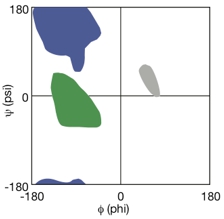In the study of protein structures, beta turns and loops represent a unique category of non-repetitive secondary structures, distinct from the more regular alpha helices and beta sheets. These structures are crucial for enabling the peptide backbone to change direction, which is essential for the compact folding of proteins. Typically, beta turns and loops are located on the surface of proteins, where hydrophilic amino acid residues can interact effectively with the surrounding aqueous environment.
Beta turns, also known as reverse turns, are characterized by their small size, consisting of fewer than four amino acid residues. They facilitate abrupt changes in the backbone direction and are stabilized by internal hydrogen bonds. In contrast, loops are longer segments of amino acids that also induce changes in backbone direction but do not possess fixed internal hydrogen bonds. This distinction is important for understanding how proteins achieve their three-dimensional shapes.
For example, a loop can be identified in a polypeptide chain when it consists of a larger segment, such as 20 amino acids, which indicates a significant change in direction without the stabilization of hydrogen bonds. Conversely, a beta turn can be recognized by its quick, U-shaped turn in the backbone, supported by internal hydrogen bonding, and typically involves fewer than four amino acids.
Visual representations of these structures often include various secondary elements, such as beta sheets and alpha helices, alongside the loops and beta turns. Recognizing these features is essential for understanding protein folding and function, as the arrangement of these structures contributes to the overall stability and activity of the protein.
As you continue to explore protein structures, consider the implications of beta turns and loops in the context of protein dynamics and interactions, as they play a vital role in the overall architecture and functionality of proteins.



